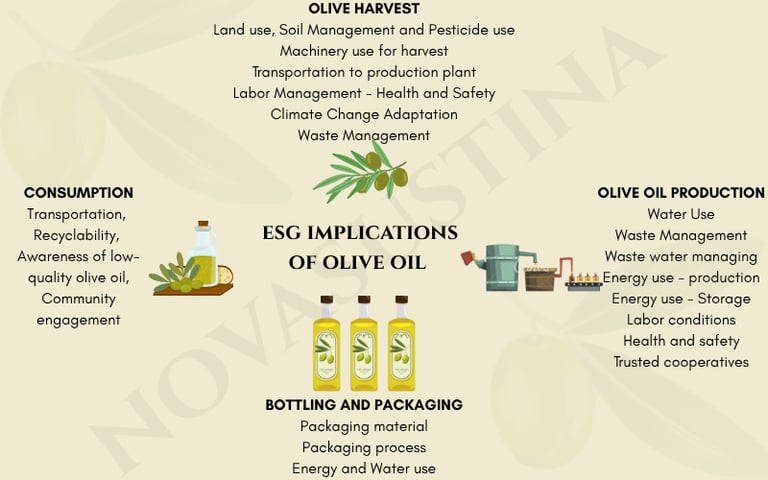Olive Oil + ESG


THE ROBUST OLIVE
Olives are as straightforward a commodity as it can be. An olive farm generates olives to be further processed for table consumption or further extracted for olive oil. The by-products of olive farming include olive pomace (residue after oil extraction), olive pits, and olive leaves (from pruning and separation at the mill). The by-products can be further used for animal feed, fertiliser, medicinal properties, building material, energy, amongst other explored uses (L. Giudice et al., 2021).
Source: Lo Giudice, V.; Faraone, I.;Bruno, M.R.; Ponticelli, M.; Labanca, F.; Bisaccia, D.; Massarelli, C.; Milella, L.; Todaro, L. 'Olive Trees By-Products as Sources of Bioactive and Other Industrially Useful Compounds: A Systematic Review'. Molecules 2021, 26, 5081. https://doi.org/10.3390/molecules26165081
OLIVE OIL PRODUCTION
Olives are high-value products with 4 million hectares of cultivated land globally (Rapa. M, et al, 2022). Majority of olives come from the Mediterranean basin - Spain (largest producer), Italy, Türkiye, Tunisia, Greece, Portugal, and Morocco (World Population Review, 2024).
Sources:
Rapa M., Ciano S., 'A Review on Life Cycle Assessment of the Olive Oil Production. Sustainability, 2022, 14, 654. https://doi.org/10.3390/su14020654
https://worldpopulationreview.com/country-rankings/olive-oil-production-by-country


MAJOR ESG ISSUES IN OLIVE OIL PRODUCTION
WASTE MANAGEMENT
Olive oil production results in less than 18% average yield; the rest comprises waste that includes olive pomace (less than 45%) and the remaining is olive mill wastewater. Inefficient disposing of the waste is a significant pollutant. Further processing of waste such as pomace presents its own carbon footprint and may not be as beneficial as other conventional methods.
Source: Rapa M., Ciano S., 'A Review on Life Cycle Assessment of the Olive Oil Production. Sustainability, 2022, 14, 654. https://doi.org/10.3390/su14020654
SOIL AND LAND MANAGEMENT
Climate change impacts olive cultivation severely as it depends on weather conditions that are optimal for quality of the olives. For example, extended periods of drought affect the water needed by these trees. Soil management is therefore impacted by irrigation and rain-fed systems, use of organic or synthetic fertilisers, and pesticides. Other areas involve preservation of olive trees as they can sequester carbon and enhance biodiversity.
Sources: Rapa M., Ciano S., 'A Review on Life Cycle Assessment of the Olive Oil Production. Sustainability, 2022, 14, 654. https://doi.org/10.3390/su14020654, https://www.aboutoliveoil.org/olive-oil-sustainability
PACKAGING MATERIAL
The olive oil supply chain involves mainly glass packaging in dark containers to avoid light influencing the oil. Glass packaging presents environmental challenges involving the weight and transportation of the glass bottles (glass being a delicate material, energy used in producing it, and weight affecting how much is transported at a time).
Source: Rapa M., Ciano S., 'A Review on Life Cycle Assessment of the Olive Oil Production. Sustainability, 2022, 14, 654. https://doi.org/10.3390/su14020654
QUALITY GOVERNANCE
The EU has recognised olive oil as highly susceptible to food fraud, like the circulation of low-quality oils and mislabeled oil varieties. Transparency and accountability in the supply chain are needed to avoid fraudulent activities.

Source: Insider Food, Published 28 March 2022. https://youtu.be/l4GrYUUcQG0?si=naSmR7vz5-7rPyox
Disclosure
This website does not send email alerts, newsletters, or unsolicited subscription requests. All contact is initiated through the contact form, which enables direct communication via personal email for those who wish to engage further.
All users are encouraged to read our Terms and Conditions
